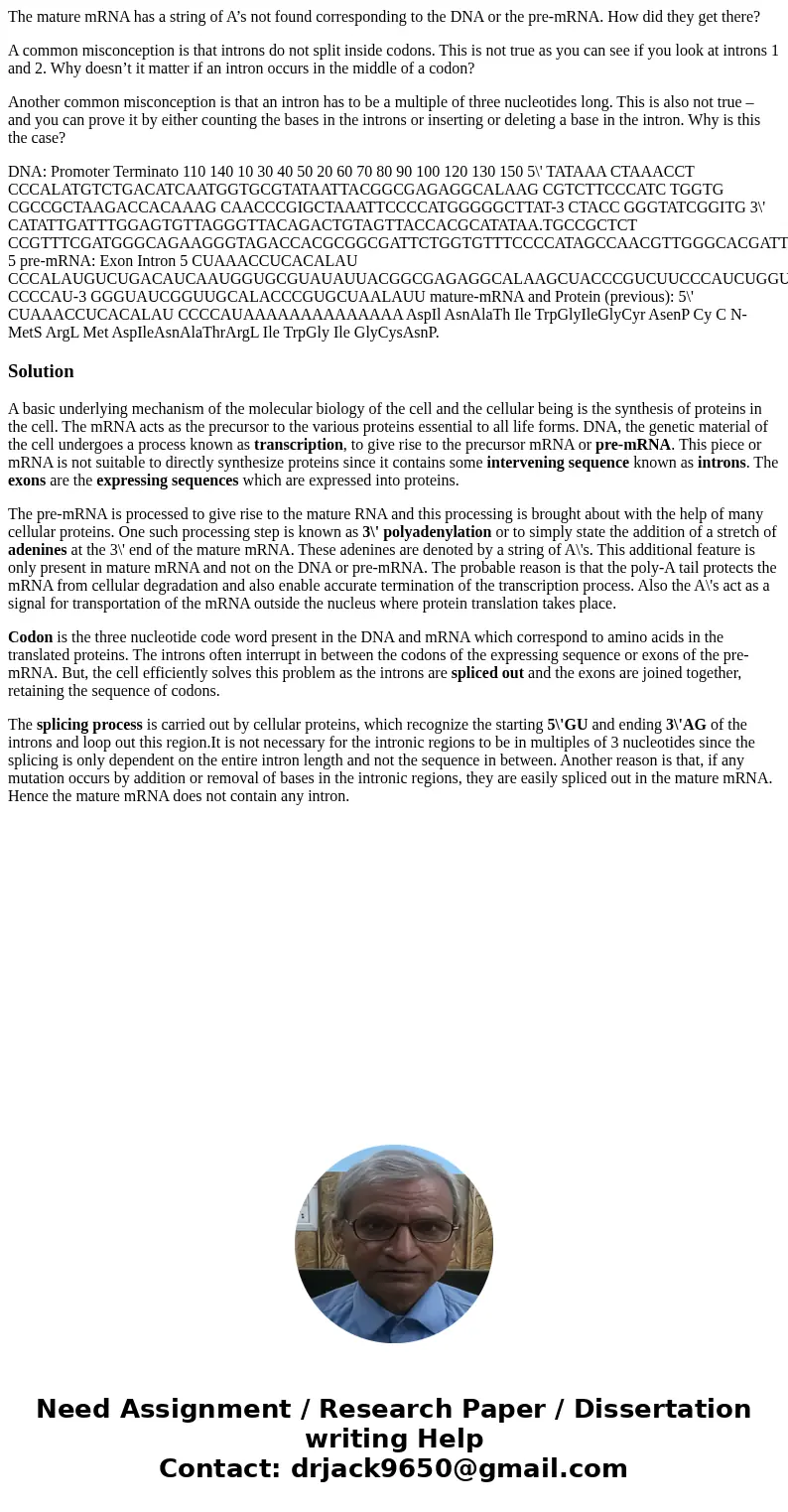The mature mRNA has a string of As not found corresponding t
The mature mRNA has a string of A’s not found corresponding to the DNA or the pre-mRNA. How did they get there?
A common misconception is that introns do not split inside codons. This is not true as you can see if you look at introns 1 and 2. Why doesn’t it matter if an intron occurs in the middle of a codon?
Another common misconception is that an intron has to be a multiple of three nucleotides long. This is also not true – and you can prove it by either counting the bases in the introns or inserting or deleting a base in the intron. Why is this the case?
DNA: Promoter Terminato 110 140 10 30 40 50 20 60 70 80 90 100 120 130 150 5\' TATAAA CTAAACCT CCCALATGTCTGACATCAATGGTGCGTATAATTACGGCGAGAGGCALAAG CGTCTTCCCATC TGGTG CGCCGCTAAGACCACAAAG CAACCCGIGCTAAATTCCCCATGGGGGCTTAT-3 CTACC GGGTATCGGITG 3\' CATATTGATTTGGAGTGTTAGGGTTACAGACTGTAGTTACCACGCATATAA.TGCCGCTCT CCGTTTCGATGGGCAGAAGGGTAGACCACGCGGCGATTCTGGTGTTTCCCCATAGCCAACGTTGGGCACGATTTAAGGGGTACCCCCGAATA-5 pre-mRNA: Exon Intron 5 CUAAACCUCACALAU CCCALAUGUCUGACAUCAAUGGUGCGUAUAUUACGGCGAGAGGCALAAGCUACCCGUCUUCCCAUCUGGUGCGCCGCUAAGACCACAAAG CCCCAU-3 GGGUAUCGGUUGCALACCCGUGCUAALAUU mature-mRNA and Protein (previous): 5\' CUAAACCUCACALAU CCCCAUAAAAAAAAAAAAAA AspIl AsnAlaTh Ile TrpGlyIleGlyCyr AsenP Cy C N-MetS ArgL Met AspIleAsnAlaThrArgL Ile TrpGly Ile GlyCysAsnP.Solution
A basic underlying mechanism of the molecular biology of the cell and the cellular being is the synthesis of proteins in the cell. The mRNA acts as the precursor to the various proteins essential to all life forms. DNA, the genetic material of the cell undergoes a process known as transcription, to give rise to the precursor mRNA or pre-mRNA. This piece or mRNA is not suitable to directly synthesize proteins since it contains some intervening sequence known as introns. The exons are the expressing sequences which are expressed into proteins.
The pre-mRNA is processed to give rise to the mature RNA and this processing is brought about with the help of many cellular proteins. One such processing step is known as 3\' polyadenylation or to simply state the addition of a stretch of adenines at the 3\' end of the mature mRNA. These adenines are denoted by a string of A\'s. This additional feature is only present in mature mRNA and not on the DNA or pre-mRNA. The probable reason is that the poly-A tail protects the mRNA from cellular degradation and also enable accurate termination of the transcription process. Also the A\'s act as a signal for transportation of the mRNA outside the nucleus where protein translation takes place.
Codon is the three nucleotide code word present in the DNA and mRNA which correspond to amino acids in the translated proteins. The introns often interrupt in between the codons of the expressing sequence or exons of the pre-mRNA. But, the cell efficiently solves this problem as the introns are spliced out and the exons are joined together, retaining the sequence of codons.
The splicing process is carried out by cellular proteins, which recognize the starting 5\'GU and ending 3\'AG of the introns and loop out this region.It is not necessary for the intronic regions to be in multiples of 3 nucleotides since the splicing is only dependent on the entire intron length and not the sequence in between. Another reason is that, if any mutation occurs by addition or removal of bases in the intronic regions, they are easily spliced out in the mature mRNA. Hence the mature mRNA does not contain any intron.

 Homework Sourse
Homework Sourse